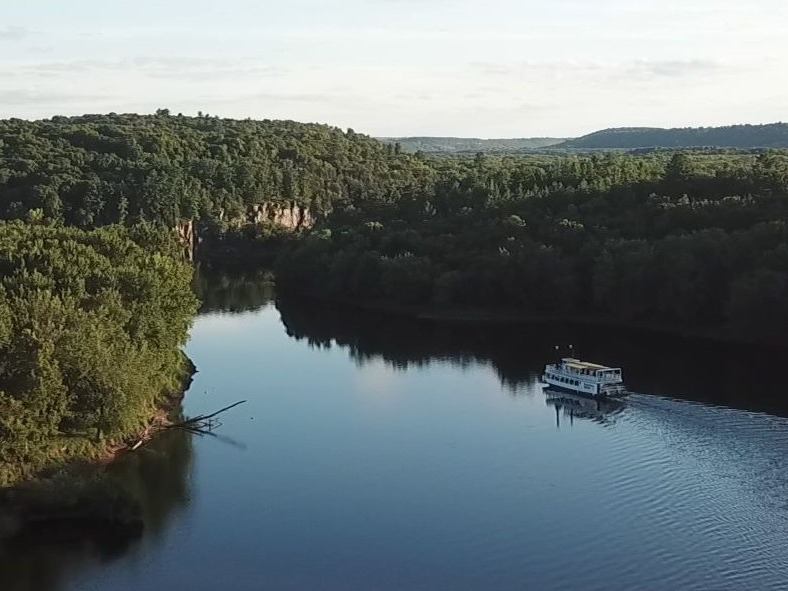Location & Overview
Taylors Falls is a small city in Chisago County in eastern Minnesota, located at the junction of U.S. Highway 8 and Minnesota State Highway 95, about 35 to 45 miles northeast of the Twin Cities metro area. It sits directly across the St. Croix River from St. Croix Falls, Wisconsin.
Covering approximately 4.24 square miles (3.94 land, 0.29 water), Taylors Falls had a 2020 population of 1,055, with around 490 housing units and a density of roughly 268 people per square mile. The city sits at an elevation of about 945 feet and carries the motto “Village on the River.”
History & Heritage
Platted in 1850–1851 and incorporated in 1858, Taylors Falls was named after early settler and territorial politician Jesse Taylor. In the 1800s, it became a thriving logging and riverboat center due to the rapids (“falls”) on the St. Croix River, which marked the farthest upstream navigable point. This made it a gateway for immigrants and lumber transport.
A dramatic historical moment occurred in 1886 with the St. Croix log jam—one of the largest in U.S. history—which temporarily halted river travel and drew massive crowds to witness cleanup efforts, including the use of dynamite.
Geography & Natural Features
Taylors Falls lies on the steep bluffs and river gorge known as the Dalles of the St. Croix River, shared with Wisconsin. It includes part of the first cross-state park in the U.S., Interstate State Park, which spans 298 acres and offers 37 campsites and several miles of trails through remarkable basalt formations and glacial potholes.
This area provides dramatic vistas and geological features recognized as globally unique.
Demographics & Community
In 2020, the racial makeup of Taylors Falls was predominantly White (91% or more), with small percentages of African American, Asian, Native American, and multiracial residents. Hispanic or Latino individuals comprised about 1.3% of the population.
The median age was around 42, and households averaged between 2.3 and 2.4 individuals. The community includes families, retirees, and seasonal residents.
Recreation & Attractions
Taylors Falls is renowned for outdoor recreation, especially within Interstate State Park. Visitors enjoy hiking, rock climbing, and viewing glacial potholes—among the densest in the world within a compact area.
Canoeing and kayaking on the scenic St. Croix River, including guided boat tours, are popular seasonal activities. The surrounding region also offers mountain-bike trails, Nordic ski routes, and arts programming via Franconia Sculpture Park, which draws approximately 180,000 visitors annually.
Downtown Taylors Falls features charming shops, cafés, old-style drive-in restaurants, galleries, and boutiques, blending rustic hospitality with small-town character.
Historic Architecture & Sites
Notable heritage sites include the Folsom House, a Greek Revival/Federal-style home of lumber baron W.H.C. Folsom, now a museum within the Angel’s Hill Historic District.
Other preserved landmarks include the Taylors Falls Public Library, housed in its original 1854 Carpenter Gothic building, and the state’s oldest public schoolhouse, built in 1852. The Old Jail and Methodist Church also contribute to the historic district’s character.
Economy & Community Life
With its small population, Taylors Falls’s economy centers on tourism, outdoor recreation, hospitality, and retail. Seasonal festivals, theater, art events, and river-based excursions support local businesses.
The area is popular with day-trippers from the Twin Cities during summer and fall foliage seasons. The community blends permanent residents with seasonal visitors, including retirees and second-home owners drawn to the scenic river valley.
Sister City & Swedish Heritage
Taylors Falls does not currently have an official sister-city relationship in Sweden, unlike neighboring Chisago County towns such as Lindström (Tingsryd), Shafer (Nöbbele), Center City (Hassela), Chisago City (Algutsboda), and Scandia (Mellerud), which maintain formal pairings marked by bilingual signage along U.S. Highway 8.
Despite this, Taylors Falls is deeply embedded in the region’s Swedish-American heritage, historically serving as the first landing point for many Swedish immigrants in the 1850s.
The town participates in cultural and heritage tourism initiatives alongside its sister-city counterparts. Visitors on the Emigrants Trail often learn about Taylors Falls’ role as the gateway settlement for Swedish emigrants and explore neighboring cities with formal sister-city ties.
Should a formal sister-city relationship develop in the future, it would likely connect to Swedish communities in Småland or Hälsingland, and be commemorated through signage, cultural exchange programs, and genealogical tourism.
Summary
Taylors Falls, Minnesota, is a captivating small city with a population around 1,055, steeped in early settler and logging-era history. Located at the dramatic Dalles gorge of the St. Croix River, it offers outstanding geological and outdoor recreation features—including Interstate State Park, glacial potholes, trails, kayaking, and art attractions like Franconia Sculpture Park.
Its historic downtown contains landmark buildings such as the Folsom House and Carpenter Gothic public library, preserving the mid-1800s legacy. The town played a critical role as the gateway for Swedish settlers arriving in Chisago County and contributes significantly to the Swedish-American heritage through the collective Emigrants Trail and regional tourism initiatives.
While Taylors Falls does not currently have a formal sister city in Sweden, it remains integral to the Swedish-connected Chisago Lakes community and features prominently alongside cities with formal Swedish sister-city relationships. The city is an essential starting point for anyone tracing Minnesota’s immigrant history and exploring scenic, heritage-rich landscapes.



